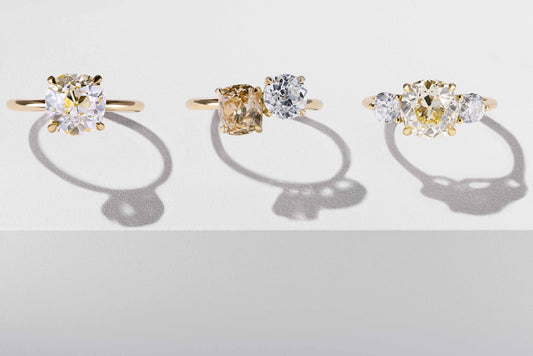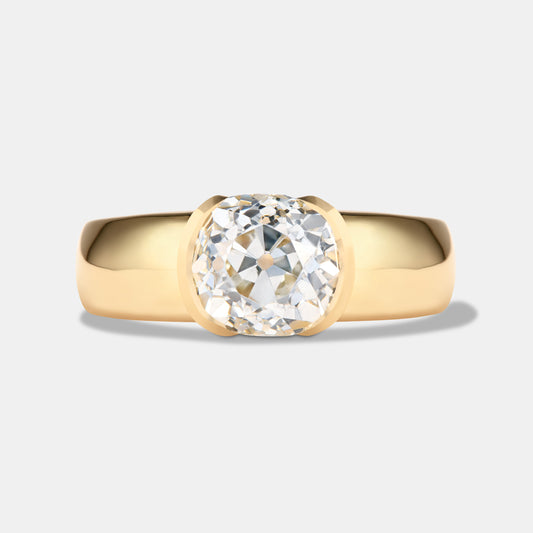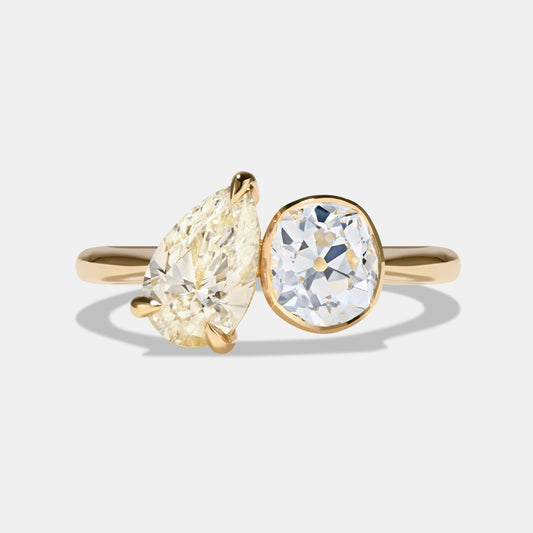OUR ANTIQUE DIAMONDS
OUR ANTIQUE DIAMOND COLLECTION
HAMISH WHITING
GIA Gemologist and HRD Antwerp Diamond Grader
Hamish Whiting is one of the three founders of our jewellery brand and our in-house Gemologist. Hamish is a highly skilled and very experienced buyer of diamonds and precious gemstones.
Hamish has taken what he has learned during his Gemology and Diamond Grading studies at the GIA in Carlsbad, and the HRD in Antwerp, and further enhanced his buying through his years of experience and extensive research.
He is currently working from the Antwerp Diamond Bourse, the centre of old world diamonds, where he has recently been honoured with an invitation to become a member of this prestigious and historically important diamond trading centre.
Having Hamish based in Antwerp grants us access to some of the rarest and most beautiful antique diamonds which we source carefully over time.

OUR ANTIQUE DIAMONDS
Antique diamonds are just that, diamonds which were mined and cut by hand between 1600 and 1930.
Antique diamonds are not to be confused with “antique style” cut diamonds - Modern cutting techniques can replicate to some degree the style of an antique cut, but most fall short in beauty and it is possible to differentiate a modern cut ‘antique style’ diamond from a genuine vintage antique diamond.

What makes Antique diamonds so special?
- Antique diamonds were cut entirely by hand giving each stone a unique character and charm, versus modern cut diamonds which are precision cut using new technologies and therefore very uniform in appearance.
- Antique diamonds have larger faceting and a softer “blocky” sparkle in contrast to the more “blingy” appearance of modern cut diamonds.
- Antique diamonds are steeped in history, each one with a unique story, each a relic of the past.
- Rarity - Antique diamonds are very difficult to source as many have been recut into modern cut diamonds over the years. The exact methods of cutting an antique diamond have been lost as they were taught generation to generation and in today’s fast paced world hand cutting methods would be deemed uneconomical.
- Eco-friendly: Antique diamonds are repurposed, as opposed to newly mined, making them a more environmentally conscious choice.
Antique diamond cuts throughout time:

OLD MINE CUTS: C. 1700 - 1900
- The discovery of rough diamonds in Brazil in the early 1700s greatly increased the supply of diamonds to European markets. Improved gas lighting and an increasing understanding of optical science led cutters to experiment with ways to improve a faceted diamond's relationship with light. This resulted in the birth of the Old Mine cut.
- Typically cushion (square with rounded off corners) shaped with 58 facets, a high crown, deep pavilion, and large culet. The unmatched brilliance and fire/scintillation of the Old Mine made it the most popular cut of the eighteenth and nineteenth centuries.
- Arguably, one of the most beautiful diamond cuts of all time, Old Mine Cuts are now incredibly rare and sought after.

OLD EURO CUT: c. 1890’s- 1930’s
- The invention of the steam driven diamond bruting machine in the late 1800s allowed cutters to fashion an evenly rounded girdle for the first time, as opposed to a cushion shape like the Old Mine. This significant advance in the cutting process led to the creation of the Old European cut.
- Possessing the same number of facets as the Old Mine cut and similar proportions (high crown, small table, shallow pavilion) but displaying a perfectly rounded girdle for the first time, the Old Euro was seen as an advancement of the Old Mine cut and rapidly became the most popular cut of the early 20th century.

PERUZZI CUT: C. 17TH CENTURY
- The Peruzzi Cut diamond was introduced by Vincent Peruzzi, a polisher from Venice in the early 17th century, and is considered one of the first "brilliant cuts" created. Before this time, most diamonds were cut in a simple facet arrangement with 8 crown facets. Peruzzi tripled the amount of facets to 33 ("triple-cut") which added a lot of fire and sparkle to the diamond.
- Even back in its period of origin, Peruzzi Cut diamonds were incredibly rare, as the majority of diamonds in that time were being cut as rose cuts, or single cuts. It's remarkable that such treasures can still be found, for example, out of a parcel of 300-400 old cuts sometimes you are lucky to even find one Peruzzi cut. They are generally extremely deep (around 80-90 percent deep), with broad facets, a prominent culet and a stunning squarish shape.
Featured collection
View all-
Dion 2.09ct Antique Old Mine Cut Diamond Solitaire Engagement Ring
 Dion 2.09ct Antique Old Mine Cut Diamond Solitaire Engagement Ring
Dion 2.09ct Antique Old Mine Cut Diamond Solitaire Engagement Ring- Regular price
- $33,000 AUD
- Regular price
-
- Sale price
- $33,000 AUD
- Unit price
- per
Dion 2.09ct Antique Old Mine Cut Diamond Solitaire Engagement Ring Dion 2.09ct Antique Old Mine Cut Diamond Solitaire Engagement Ring
Dion 2.09ct Antique Old Mine Cut Diamond Solitaire Engagement Ring- Regular price
- $33,000 AUD
- Regular price
-
- Sale price
- $33,000 AUD
- Unit price
- per
-
Dani 2.07ctw Diamond Toi Et Moi Engagement Ring
 Dani 2.07ctw Diamond Toi Et Moi Engagement Ring
Dani 2.07ctw Diamond Toi Et Moi Engagement Ring- Regular price
- $20,000 AUD
- Regular price
-
- Sale price
- $20,000 AUD
- Unit price
- per
Dani 2.07ctw Diamond Toi Et Moi Engagement Ring Dani 2.07ctw Diamond Toi Et Moi Engagement Ring
Dani 2.07ctw Diamond Toi Et Moi Engagement Ring- Regular price
- $20,000 AUD
- Regular price
-
- Sale price
- $20,000 AUD
- Unit price
- per
-
Enid 1.24ctw Antique Old European Cut Diamond Eternity Ring
 Enid 1.24ctw Antique Old European Cut Diamond Eternity Ring
Enid 1.24ctw Antique Old European Cut Diamond Eternity Ring- Regular price
- $8,500 AUD
- Regular price
-
- Sale price
- $8,500 AUD
- Unit price
- per
Enid 1.24ctw Antique Old European Cut Diamond Eternity Ring Enid 1.24ctw Antique Old European Cut Diamond Eternity Ring
Enid 1.24ctw Antique Old European Cut Diamond Eternity Ring- Regular price
- $8,500 AUD
- Regular price
-
- Sale price
- $8,500 AUD
- Unit price
- per
-
Elizabeth 2.50ct Antique Old European Cut Diamond Solitaire Engagement Ring
 Elizabeth 2.50ct Antique Old European Cut Diamond Solitaire Engagement Ring
Elizabeth 2.50ct Antique Old European Cut Diamond Solitaire Engagement Ring- Regular price
- $40,000 AUD
- Regular price
-
- Sale price
- $40,000 AUD
- Unit price
- per
Elizabeth 2.50ct Antique Old European Cut Diamond Solitaire Engagement Ring Elizabeth 2.50ct Antique Old European Cut Diamond Solitaire Engagement Ring
Elizabeth 2.50ct Antique Old European Cut Diamond Solitaire Engagement Ring- Regular price
- $40,000 AUD
- Regular price
-
- Sale price
- $40,000 AUD
- Unit price
- per



